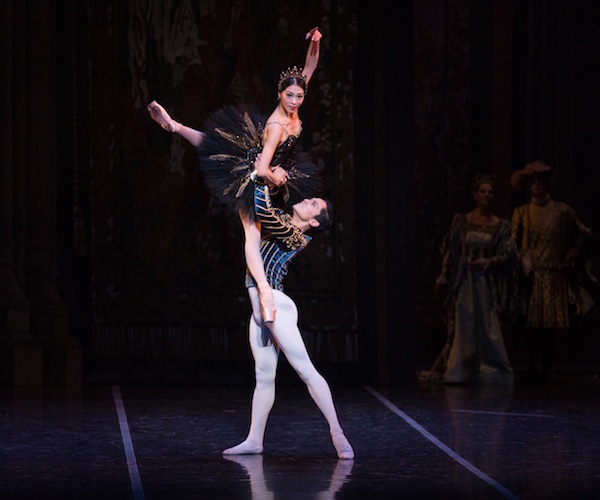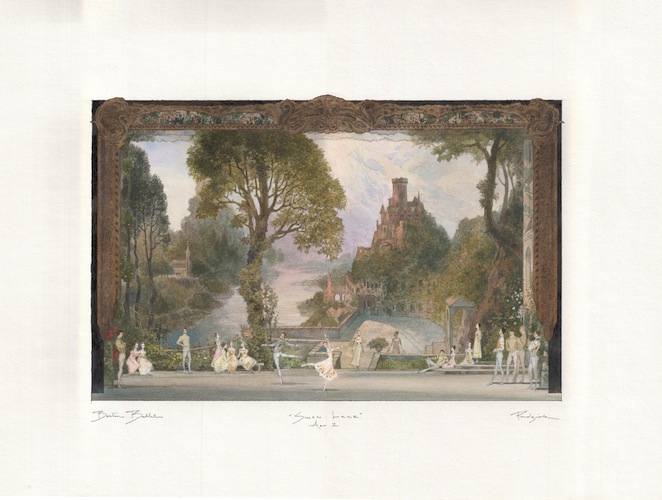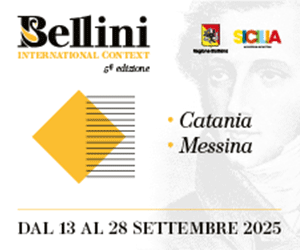Dance Review: Boston Ballet’s “Swan Lake” – A Reverent Visit into the World of Renaissance European Fairy Tale
If you know Swan Lake, there will be few structural surprises. Girl turned into swan, prince falls in love, prince gets fooled, they both feel really terrible, and together, die to some glorious chords.
Swan Lake , a Boston Ballet world premiere, adapted and additional choreography by Mikko Nissinen after original by Marius Petipa and Lev Ivanov, music by Peter Ilyich Tchakovsky, design by Robert Perdziola, at the Boston Opera House, Boston, MA. Continues, with rotating casts, through November 16.

Misa Kuranaga and Jeffrey Cirio in the Boston Ballet production of “Swan Lake.”
By Debra Cash
Boston Ballet Artistic Director Mikko Nissinen makes only one unconventional decision in the company’s refurbished version of Swan Lake: he gives it an efficient back story. During the famous Tchaikovsky overture, the coat of arms-decked curtain opens on a placid lakeside where young couples court and talk. The scene is all ruffles and parasols. One woman, sitting on the lawn, is engrossed in a book. A debonair gentleman starts to talk her up, but before she knows it, he is hauling her into the underbrush. This is a scene of kidnapping and rape, except that the young lady won’t be murdered: she will be turned into a swan.
Robert Perdziola’s collaboration with Nissinen is otherwise a reverent visit into the world of Renaissance European fairy tale, where gothic and for that matter psychologically-driven details are kept to a minimum. There’s no trace of the earlier Boston Ballet and Hamburg Ballet productions that waved to the swan obsessions of Mad King Ludwig II of Bavaria, or famously controversial productions that had the prince oedipally entangled with his mother (Erik Bruhn) or homosexually involved with his Tutor (Rudolph Nureyev). Nissinen hasn’t tampered with the familiar set pieces of Petipa and Ivanov (the story of which choreographer did what and how the classic has been handled down is a complicated and contentious one): if you know Swan Lake, there will be few structural surprises. Girl turned into swan, prince falls in love, prince gets fooled, they both feel really terrible, and together, die to some glorious chords.
Robert Perdziola‘s new sets and costumes for Swan Lake may not be as eye-catching as those he devised for the company’s Nutcracker two years ago, but they’re gracious and meaningful. The scene of the Castle Gardens opens with a backdrop featuring a castle keep and receding cypress groves drawn in the warm taupes of Leonardo, and the dancers’ costumes are muted with memory, except for the few bright spots worn by the dancers of the first act pas de trois (where Dusty Button made a particularly vivacious impression in orange). There’s a crescent moon in an inky sky that moves just a bit between the prince’s meeting the swan queen and his betrayal, as if to note that the moon hasn’t had time to wax any larger. He goes bright for the dancers in the tapestry-draped Castle Ballroom as if the brightness of the “real” world is intruding on the dreamy plot. I especially liked the costumes for the paired couples in the Spanish dance — opposite designs in black and white — that played out Swan Lake’s symmetry, and the touch of having the six “identical” princesses Siegfried is asked to choose among carrying “swan feather” fans. Perdziola’s design decision are thematic, not just atmospheric, and that’s what makes them so good.
Misa Kuranaga, who danced opening night of this world premiere production, has been a Boston Ballet principal since 2009. This Japanese-born dancer is tiny and fleet, which makes her a natural in the teenage roles of Cinderella and Sleeping Beauty but not so obvious a choice for a Swan Queen. But she was triumphant.

Robert Perdziola’s set design for Act I of “Swan Lake” for the Boston Ballet.
Kuranaga’s White Swan, Odette, reminded me that swans have hollow bones. Nuzzling her head towards an upraised “wing,” she seemed to almost dislocate her neck, and her splayed fingers feathered out from her wrists. As Odette, Kuranaga’s more otherworldly than sorrowing — a woman who thought she had adjusted to her transformation — but when she leans against her prince’s chest, and her head fits just so, she seems to relax. She has the technical goods for Odette — especially nice timing on her pique turns — but where she really shines is Odile, the disguised Black Swan who is the daughter of the venal sorcerer and who manages to get the prince to break his vow of marriage. She gives an astringent performance, using her legs like icepicks, her seduction completely deliberate, her turns a series of triple fouettes with one arm over her head just to make the show-stopping move even harder. No wonder her prince is mesmerized.
As the opening night Prince Siegfried, Kuranaga was matched with Jeffrey Cirio. They’re often paired: of Filipino descent, he’s small, too, and they have good onstage chemistry. His portrayal was a prince who may have been born to the job, but never particularly relished it. Cirio gives scissoring jumps real clarity and ends each sequence softly through his feet with an almost demure, gentlemanly presentation. (There were no ill effects from a nasty stumble into a niagra of dry ice.) The problem was that Prince Siegfried’s indecision and then terrible mistake should be the engine of Swan Lake‘s plot, and no one seems to have coached Cirio or anyone else on stage for that matter, in the subtleties of 19th century mime. Touching the side of his head during a conversation with his tutor, he could have been asking for an asprin.
Swan Lake centers on the love of its central couple, but it is always bolstered by the corps de ballet: the courtiers who honor their prince, the enchanted swans who gather in the moonlight, the dignitaries who attend the ball. Boston Ballet isn’t world class as it moves down in its company roster: some of the dancing had raw edges, messy landings, and lackluster presences — but this production opened with every sign of being well-rehearsed and will probably get stronger over the course of the engagement. Jonathan McPhee and the orchestra — especially the melting playing of concertmaster Michael Rosenbloom, oboist Barbara LaFitte, bassoon Donald Bravo and harpist Cynthia Price-Glynn — kept the score’s vivid colors intact.
Debra Cash has reported, taught and lectured on dance, performing arts, design and cultural policy for print, broadcast and internet media. She regularly presents pre-concert talks, writes program notes and moderates events sponsored by World Music/CRASHarts and cultural venues throughout New England. A former Boston Globe and WBUR dance critic, she is a two-time winner of the Creative Arts Award for poetry from the Hadassah-Brandeis Institute and will return to the 2014 Bates Dance Festival as Scholar in Residence.
c 2014 Debra Cash


Touching his hand to his head was a nod to his mother’s mime doing the same thing – in other words, “think about what I said, I want you to be engaged and married.” It doesn’t take a rocket scientist to understand that he was burdened with that thought.
That is what he was supposed to mime but not what it looked like.